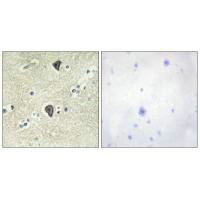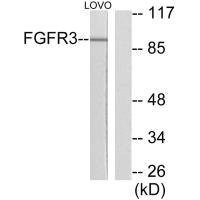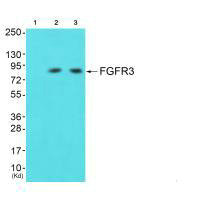
Immunohistochemical analysis of paraffin-embedded human breast carcinoma tissue using FGFR3 antibody.
FGFR3 Antibody

CSB-PA164777
ApplicationsWestern Blot, ELISA, ImmunoHistoChemistry
Product group Antibodies
ReactivityHuman
TargetFGFR3
Overview
- SupplierCusabio
- Product NameFGFR3 Antibody
- Delivery Days Customer20
- ApplicationsWestern Blot, ELISA, ImmunoHistoChemistry
- CertificationResearch Use Only
- ClonalityPolyclonal
- ConjugateUnconjugated
- Gene ID2261
- Target nameFGFR3
- Target descriptionfibroblast growth factor receptor 3
- Target synonymsACH; CD333; CEK2; FGFR-3; fibroblast growth factor receptor 3; fibroblast growth factor receptor 3 variant 4; fibroblast growth factor receptor 3-S; HSFGFR3EX; hydroxyaryl-protein kinase; JTK4; tyrosine kinase JTK4
- HostRabbit
- IsotypeIgG
- Protein IDP22607
- Protein NameFibroblast growth factor receptor 3
- Scientific DescriptionTyrosine-protein kinase that acts as cell-surface receptor for fibroblast growth factors and plays an essential role in the regulation of cell proliferation, differentiation and apoptosis. Plays an essential role in the regulation of chondrocyte differentiation, proliferation and apoptosis, and is required for normal skeleton development. Regulates both osteogenesis and postnatal bone mineralization by osteoblasts. Promotes apoptosis in chondrocytes, but can also promote cancer cell proliferation. Required for normal development of the inner ear. Phosphorylates PLCG1, CBL and FRS2. Ligand binding leads to the activation of several signaling cascades. Activation of PLCG1 leads to the production of the cellular signaling molecules diacylglycerol and inositol 1,4,5-trisphosphate. Phosphorylation of FRS2 triggers recruitment of GRB2, GAB1, PIK3R1 and SOS1, and mediates activation of RAS, MAPK1/ERK2, MAPK3/ERK1 and the MAP kinase signaling pathway, as well as of the AKT1 signaling pathway. Plays a role in the regulation of vitamin D metabolism. Mutations that lead to constitutive kinase activation or impair normal FGFR3 maturation, internalization and degradation lead to aberrant signaling. Over-expressed or constitutively activated FGFR3 promotes activation of PTPN11/SHP2, STAT1, STAT5A and STAT5B. Secreted isoform 3 retains its capacity to bind FGF1 and FGF2 and hence may interfere with FGF signaling. Jing Chen, Blood, Jul 2005; 106: 328 - 337. Qing Zhang, Diabetes, Jan 2007; 56: 96 - 106. Nigel P. Pringle, Development, Jan 2003; 130: 93. Gladys Valverde-Franco, Hum. Mol. Genet., Feb 2004; 13: 271 - 284.
- ReactivityHuman
- Storage Instruction-20°C or -80°C
- UNSPSC12352203


